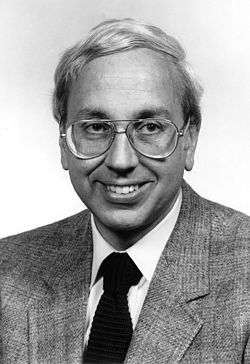John D. Anderson
John D. Anderson Jr. (born October 1, 1937) is the Curator of Aerodynamics at the National Air and Space Museum at the Smithsonian Institution in Washington, DC and Professor Emeritus in the Department of Aerospace Engineering at the University of Maryland, College Park.[1]
John Anderson | |
|---|---|
 | |
| Born | October 1, 1937 |
| Nationality | United States |
| Alma mater | University of Florida Ohio State University |
| Known for | Curator of Aerodynamics at the National Air and Space Museum |
| Scientific career | |
| Fields | Aerospace engineering |
| Institutions | Smithsonian Institution |
Biography
John D. Anderson Jr. was born on October 1, 1937 in Lancaster, Pennsylvania. He enrolled at the University of Florida in Gainesville in approximately 1953. In 1959, he earned a bachelor's degree in Aeronautical Engineering with high honors. In 1959, he was hired by the United States Air Force to become a Task Scientist at the Aerospace Research Laboratory, Wright-Patterson Air Force Base in Dayton, Ohio. He stayed in that position until 1962, when he enrolled at The Ohio State University in Columbus under fellowships from the National Science Foundation and NASA. In 1966, Anderson earned his Ph.D. in Aeronautical and Astronautical Engineering from Ohio State. That same year, he joined the United States Naval Ordnance Laboratory in White Oak, Maryland, becoming the Chief of the Hypersonic Group.[2]
In 1973, Anderson joined the faculty of the University of Maryland, becoming Chairman of the Department of Aerospace Engineering. He became Professor of Aerospace Engineering in 1980, serving in that capacity until 1999, when he retired and was named Professor Emeritus, he also served as an affiliate member of the History Department at UMD. In the year 2000 was established by the A. James Clark School of Engineering joint with the Department of Aerospace Engineering the John Anderson Scholarship Fund in his honor.[3]
He is currently the Curator of Aerodynamics at the Smithsonian Institution's National Air and Space Museum.
Books
- Gas Dynamic Lasers: An Introduction, Academic Press (1976), and under McGraw-Hill
- Introduction to Flight, McGraw-Hill, 1st Edition (1978), 2nd Edition, (1985), 3rd Edition (1989), 4th Edition (2000), 5th Edition (2005), 6th Edition (2008), 7th Edition (2011), 8th Edition(2015).
- Modern Compressible Flow, McGraw Hill, 1st Edition (1982), 2nd Edition (1990), 3rd Edition (2002)
- Fundamentals of Aerodynamics, 1st Edition (1984), 2nd Edition (1991), 3rd Edition (2001), 4th Edition (2006), 5th Edition (2010)
- Hypersonic and High Temperature Gas Dynamics, 1st Edition (1989), 2nd Edition (2000), 2nd Revised Edition (2006)
- Computational Fluid Dynamics: The Basics with Applications, McGraw Hill, (1995)
- A History of Aerodynamics and Its Impact on Flying Machines, Cambridge University Press, (1997)
- Aircraft Performance and Design, McGraw-Hill, (1999)
- The Airplane: A History of Its Technology, American Institute of Aeronautics and Astronautics, (2002)
- Inventing Flight: The Wright Brothers and Their Predecessors, Johns Hopkins University Press, (2004)
- X-15: The World′s Fastest Rocket Plane and the Pilots Who Ushered in the Space Age, Zenith Press, (2014)
References
- "Dr. John D. Anderson Jr., Smithsonian National and Air Space Museum". Retrieved 10 September 2017.
- "Biographical Sketch: John D. Anderson Jr". Retrieved 8 August 2013.
- "John Anderson Scholarship Fund,". Retrieved 10 September 2017.